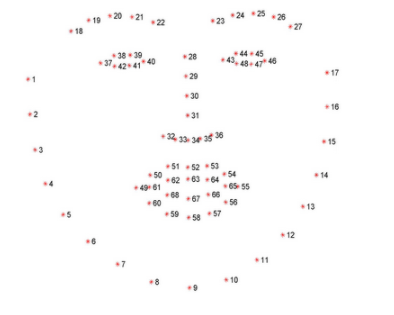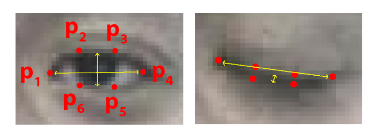项目实战—疲劳检测
我们在上次已经讲过人脸的关键点定位,用到了Dlib的库,这次我们将其用于疲劳检测。
代码实现
1、导入工具包
from scipy.spatial import distance as dist import numpy as np import dlib import cv2
接下来老样子。
2、对脸上的部位进行定义
在关键点定位的官方文档中,提取68个关键点来表示脸上的部位。其中:
第1个点到第17个点:脸颊;
第18个点到第22个点:右边眉毛;
第23个点到第27个点:左边眉毛;
第28个点到第36个点:鼻子;
第37个点到第42个点:右眼;
第43个点到第48个点:左眼;
第49个点到第68个点:嘴巴。
如下图所示:

FACIAL_LANDMARKS_68_IDXS = dict([
("mouth", (48, 68)),
("right_eyebrow", (17, 22)),
("left_eyebrow", (22, 27)),
("right_eye", (36, 42)),
("left_eye", (42, 48)),
("nose", (27, 36)),
("jaw", (0, 17))
])3、EAR(eye aspect ratio)计算函数
在论文:Real-Time Eye Blink Detection using Facial Landmarks中,EAR的概念被提出。
在包含着人眼的图片中画出六个点,如图所示:

当人眨眼时,这六个点的距离会发生变化,则可以用这六个点的一些距离关系来判断是否有眨眼行为。
定义EAR函数:

def eye_aspect_ratio(eye): # 计算距离,竖直的 A = dist.euclidean(eye[1], eye[5]) B = dist.euclidean(eye[2], eye[4]) # 计算距离,水平的 C = dist.euclidean(eye[0], eye[3]) # ear值 ear = (A + B) / (2.0 * C) return ear
5、设置判断参数
如果EAR小于0.3,则判断为闭眼,如果视频中有连续三帧以上都有闭眼,则判断为眨眼行为
# 设置判断参数 EYE_AR_THRESH = 0.3 # ear小于0.3判断为闭眼 EYE_AR_CONSEC_FRAMES = 3 # 连续三帧ear都小于0.3判断为眨眼 # 初始化计数器 COUNTER = 0 TOTAL = 0
6、加载dlib库中的人脸检测与关键点定位
detector = dlib.get_frontal_face_detector()
predictor = dlib.shape_predictor('shape_predictor_68_face_landmarks.dat')7、分别取两个眼睛区域
(lStart, lEnd) = FACIAL_LANDMARKS_68_IDXS["left_eye"] (rStart, rEnd) = FACIAL_LANDMARKS_68_IDXS["right_eye"]
8、读取视频
vs = cv2.VideoCapture('test.mp4')9、对每一帧图片进行操作,实现功能
· 读取一帧图片并做预处理操作;
· 检测人脸;
· 获取人脸上的关键点坐标;
· 绘制眼睛区域;
· 计算左右两眼的EAR值,取平均值得到总的EAR值;
· 检查EAR值是否满足阈值,如果满足,眨眼次数加一;
· 将总的眨眼次数写在视频中。
# 遍历每一帧
while True:
# 预处理
frame = vs.read()[1]
if frame is None:
break
(h, w) = frame.shape[:2]
width=1200
r = width / float(w)
dim = (width, int(h * r))
frame = cv2.resize(frame, dim, interpolation=cv2.INTER_AREA)
gray = cv2.cvtColor(frame, cv2.COLOR_BGR2GRAY)
# 检测人脸
rects = detector(gray, 0)
# 遍历每一个检测到的人脸
for rect in rects:
# 获取坐标
shape = predictor(gray, rect)
shape = shape_to_np(shape)
# 分别计算ear值
leftEye = shape[lStart:lEnd]
rightEye = shape[rStart:rEnd]
leftEAR = eye_aspect_ratio(leftEye)
rightEAR = eye_aspect_ratio(rightEye)
# 算一个平均的
ear = (leftEAR + rightEAR) / 2.0
# 绘制眼睛区域
leftEyeHull = cv2.convexHull(leftEye)
rightEyeHull = cv2.convexHull(rightEye)
cv2.drawContours(frame, [leftEyeHull], -1, (0, 255, 0), 1)
cv2.drawContours(frame, [rightEyeHull], -1, (0, 255, 0), 1)
# 检查是否满足阈值
if ear < EYE_AR_THRESH:
COUNTER += 1
else:
# 如果连续几帧都是闭眼的,总数算一次
if COUNTER >= EYE_AR_CONSEC_FRAMES:
TOTAL += 1
# 重置
COUNTER = 0
# 显示
cv2.putText(frame, "Blinks: {}".format(TOTAL), (10, 30),
cv2.FONT_HERSHEY_SIMPLEX, 0.7, (0, 0, 255), 2)
cv2.putText(frame, "EAR: {:.2f}".format(ear), (300, 30),
cv2.FONT_HERSHEY_SIMPLEX, 0.7, (0, 0, 255), 2)
cv2.imshow("Frame", frame)
key = cv2.waitKey(10) & 0xFF
if key == 27:
break
vs.release()
cv2.destroyAllWindows()我们可以看最终效果。


